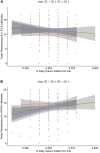Longitudinal Associations Between Taste Sensitivity, Taste Liking, Dietary Intake and BMI in Adolescents
- PMID: 33679519
- PMCID: PMC7935517
- DOI: 10.3389/fpsyg.2021.597704
Longitudinal Associations Between Taste Sensitivity, Taste Liking, Dietary Intake and BMI in Adolescents
Abstract
Taste sensitivity and liking drive food choices and ingestive behaviors from childhood to adulthood, yet their longitudinal association with dietary intake and BMI is largely understudied. Here, we examined the longitudinal relationship between sugar and fat sensitivity, sugar and fat liking, habitual dietary intake, and BMI percentiles in a sample of 105 healthy-weight adolescents (baseline: BMI %tile 57.0 ± 24.3; age 14-16 years) over a 4-year period. Taste sensitivity was assessed via a triangle fat and sweet taste discrimination test. Taste liking were rated on a visual analog scale for four milkshakes that varied in sugar and fat contents (high-fat/high-sugar (HF/HS), low-fat/high-sugar (LF/HS), high-fat/low-sugar (HF/LS), low-fat/low-sugar (LF/LS) milkshakes). A modified version of the reduced Block Food Frequency Questionnaire (BFFQ) was used to assess dietary intake. All measurements were repeated annually. Repeated measures correlations and linear mixed effects models were used to model the associations between the variables. Sugar sensitivity was negatively associated with liking for the LF/HS milkshake over the 4-year period. Low sugar sensitivity at baseline predicted increases in BMI percentile over time, but this association didn't survive a correction for multiple comparisons. Percent daily intake from fat was positively associated with liking for the HF/HS milkshake and negatively associated with liking for the LF/LS milkshake over 4 years. Together, these results demonstrate that lower sensitivity to sweet taste is linked to increased hedonic response to high-sugar foods and increased energy intake from fat seems to condition adolescents to show increased liking for high-fat/high-sugar foods.
Keywords: adolescents; dietary intake; fat; hedonic ratings; sugar.
Copyright © 2021 Papantoni, Shearrer, Sadler, Stice and Burger.
Conflict of interest statement
The authors declare that the research was conducted in the absence of any commercial or financial relationships that could be construed as a potential conflict of interest.
Figures



Similar articles
-
Associations between sweet taste function, oral complex carbohydrate sensitivity, liking and consumption of ad libitum sweet and non-sweet carbohydrate milkshakes among female adults.Br J Nutr. 2019 Oct 14;122(7):829-840. doi: 10.1017/S0007114519001703. Br J Nutr. 2019. PMID: 31309910
-
Is Sweet Taste Perception Associated with Sweet Food Liking and Intake?Nutrients. 2017 Jul 14;9(7):750. doi: 10.3390/nu9070750. Nutrients. 2017. PMID: 28708085 Free PMC article.
-
Effects of Sweet-Liking on Body Composition Depend on Age and Lifestyle: A Challenge to the Simple Sweet-Liking-Obesity Hypothesis.Nutrients. 2020 Sep 4;12(9):2702. doi: 10.3390/nu12092702. Nutrients. 2020. PMID: 32899675 Free PMC article.
-
Understanding sweet-liking phenotypes and their implications for obesity: Narrative review and future directions.Physiol Behav. 2021 Jun 1;235:113398. doi: 10.1016/j.physbeh.2021.113398. Epub 2021 Mar 23. Physiol Behav. 2021. PMID: 33771526 Review.
-
Influence of Sensory Properties in Moderating Eating Behaviors and Food Intake.Front Nutr. 2022 Feb 21;9:841444. doi: 10.3389/fnut.2022.841444. eCollection 2022. Front Nutr. 2022. PMID: 35265658 Free PMC article. Review.
Cited by
-
Regulator of G-Protein Signalling 9: A New Candidate Gene for Sweet Food Liking?Foods. 2023 Apr 22;12(9):1739. doi: 10.3390/foods12091739. Foods. 2023. PMID: 37174278 Free PMC article.
-
Associations between Sweet Taste Sensitivity and Polymorphisms (SNPs) in the TAS1R2 and TAS1R3 Genes, Gender, PROP Taster Status, and Density of Fungiform Papillae in a Genetically Homogeneous Sardinian Cohort.Nutrients. 2022 Nov 19;14(22):4903. doi: 10.3390/nu14224903. Nutrients. 2022. PMID: 36432589 Free PMC article.
-
Prolonged latency of the gustatory evoked potentials for sucrose solution in subjects living with obesity compared with normal-weight subjects.Int J Obes (Lond). 2024 Dec;48(12):1720-1727. doi: 10.1038/s41366-024-01607-2. Epub 2024 Aug 25. Int J Obes (Lond). 2024. PMID: 39183345 Clinical Trial.
-
Basic taste sensitivity, eating behaviour, food propensity and BMI of preadolescent children: How are they related?Open Res Eur. 2024 Feb 2;1:127. doi: 10.12688/openreseurope.14117.3. eCollection 2021. Open Res Eur. 2024. PMID: 38433733 Free PMC article.
-
Taste of Fat and Obesity: Different Hypotheses and Our Point of View.Nutrients. 2022 Jan 27;14(3):555. doi: 10.3390/nu14030555. Nutrients. 2022. PMID: 35276921 Free PMC article. Review.
References
Grants and funding
LinkOut - more resources
Full Text Sources
Other Literature Sources
Research Materials
Miscellaneous

